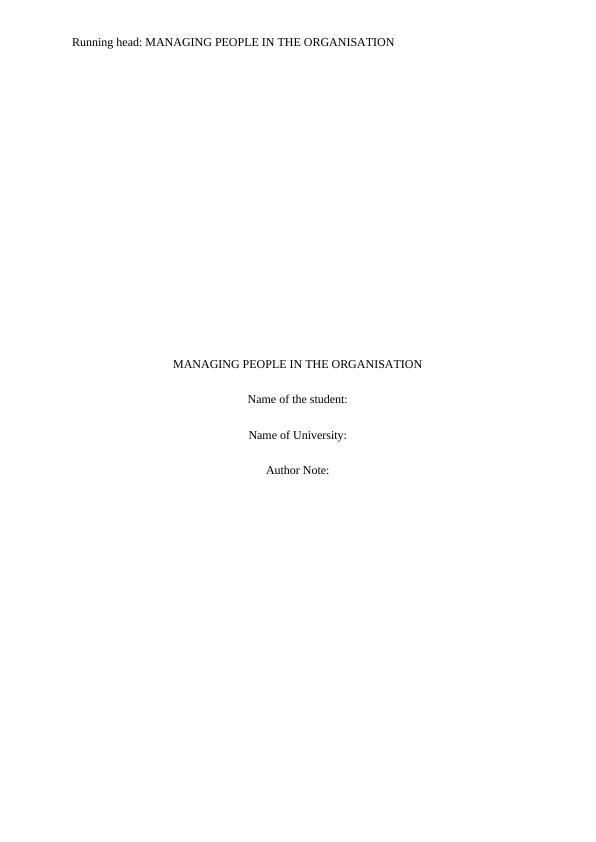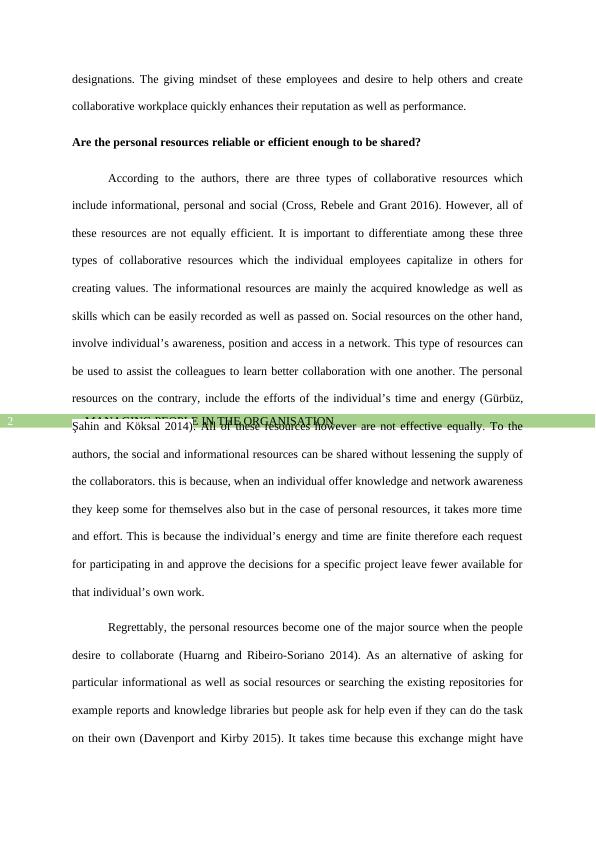Managing People In an Organisation
Added on 2019-10-31
9 Pages2592 Words158 Views
Running head: MANAGING PEOPLE IN THE ORGANISATIONMANAGING PEOPLE IN THE ORGANISATIONName of the student:Name of University:Author Note:

MANAGING PEOPLE IN THE ORGANISATION1In this current setting of organizations, most of the CEOs and the human resourcemanagement executives, found collaborative works to be the most important and commonfactor for their success. In this particular method, two or more people form teams to worktogether and share their ideas and knowledge for accomplishing a common goal. Teamworktakes the job at higher level because it does not depend on the ideas of one individual butincorporate the upgraded knowledge of technological advancements thus focus on thepurpose and accomplish it within limited time. To Luca, Kleinberg and Mullainathan, “An algorithm can tell you whichemployees are most likely to succeed without identifying which attributesare most important for success” (2016). In this article named, ‘AlgorithmsNeed Mangers, Too’ the authors support the means of algorithm to makeperfect prediction. According to the researchers like Cross, Rebele and Grant,collaboration in the workplace in the current business setting has been increasing (2016). Thebusiness has been becoming more and more cross cultural and global. This is the reason whythe tendency of collaborative work has developed. Certainly these development has beenapplauded but the over consumption of valued resources can be a barrier for suchdevelopment. In the critical point of decision making or getting a difficult job done, themanagers cannot arrange meetings where the employees can form a team, meet and sharetheir knowledge to accomplish the job. The critical work allows the employees little time toaccess the resources. The researches have revealed that the distribution of the collaborativeworks is often uneven. In most of the cases the cases, 20% to 35% of the value addedcollaborations come from 3 to 5% of employees in the organizations these people becomeknown to have more personal resources and capable to share them with others (Cross, Rebeleand Grant 2016). Moreover, they are willing to help others. This is the reason why theseemployees are being taken into the projects and incorporated into the more important

MANAGING PEOPLE IN THE ORGANISATION2designations. The giving mindset of these employees and desire to help others and createcollaborative workplace quickly enhances their reputation as well as performance. Are the personal resources reliable or efficient enough to be shared?According to the authors, there are three types of collaborative resources whichinclude informational, personal and social (Cross, Rebele and Grant 2016). However, all ofthese resources are not equally efficient. It is important to differentiate among these threetypes of collaborative resources which the individual employees capitalize in others forcreating values. The informational resources are mainly the acquired knowledge as well asskills which can be easily recorded as well as passed on. Social resources on the other hand,involve individual’s awareness, position and access in a network. This type of resources canbe used to assist the colleagues to learn better collaboration with one another. The personalresources on the contrary, include the efforts of the individual’s time and energy (Gürbüz,Şahin and Köksal 2014). All of these resources however are not effective equally. To theauthors, the social and informational resources can be shared without lessening the supply ofthe collaborators. this is because, when an individual offer knowledge and network awarenessthey keep some for themselves also but in the case of personal resources, it takes more timeand effort. This is because the individual’s energy and time are finite therefore each requestfor participating in and approve the decisions for a specific project leave fewer available forthat individual’s own work.Regrettably, the personal resources become one of the major source when the peopledesire to collaborate (Huarng and Ribeiro-Soriano 2014). As an alternative of asking forparticular informational as well as social resources or searching the existing repositories forexample reports and knowledge libraries but people ask for help even if they can do the taskon their own (Davenport and Kirby 2015). It takes time because this exchange might have

End of preview
Want to access all the pages? Upload your documents or become a member.
Related Documents
Organisational Issues: Collaborative Overload and Algorithms Need Managerslg...
|7
|1690
|231
Collaborative Overload - PDFlg...
|8
|2005
|135
Collaborative Measures in Organisationlg...
|7
|1785
|344
Trends in the Global Business Environmentlg...
|10
|2237
|473
Communication and Collaborative Working in PDFlg...
|9
|2505
|23
Human Resource Management: Functions, Roles, and Importancelg...
|21
|6046
|357
